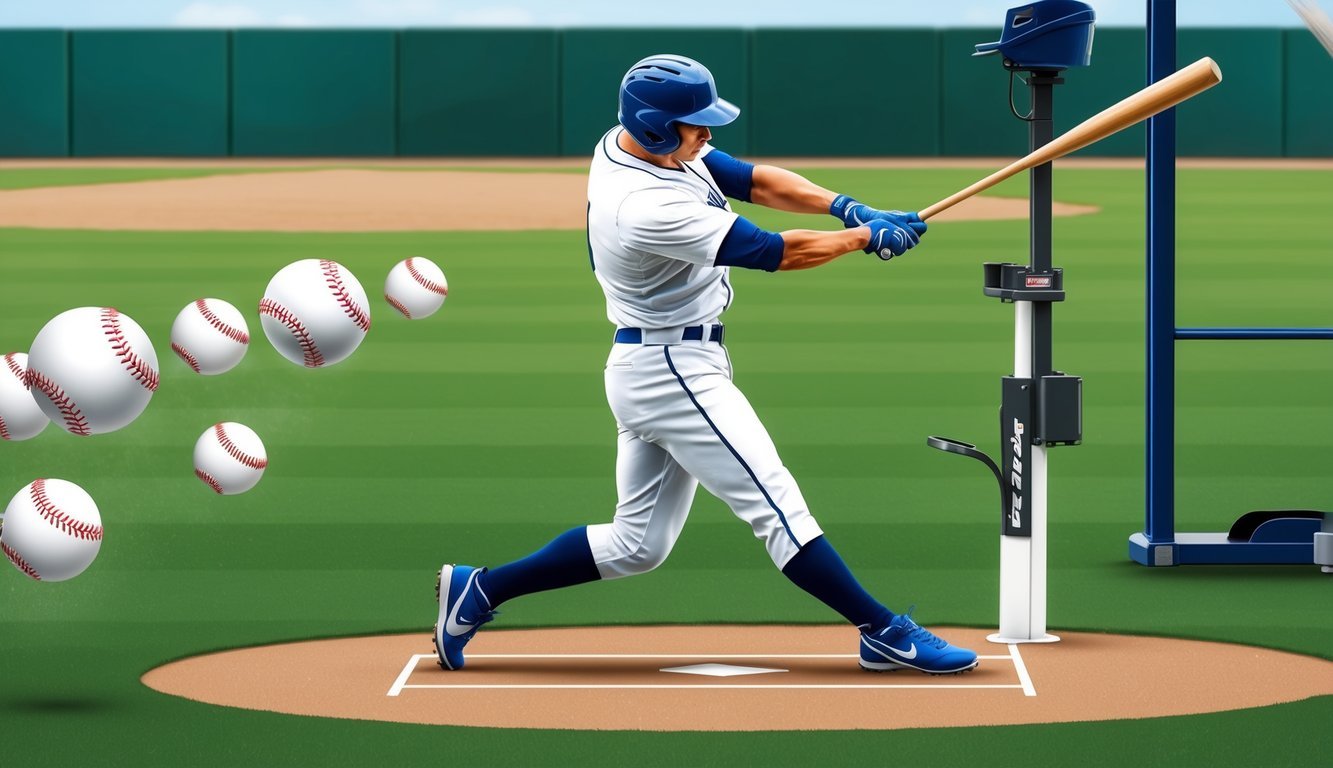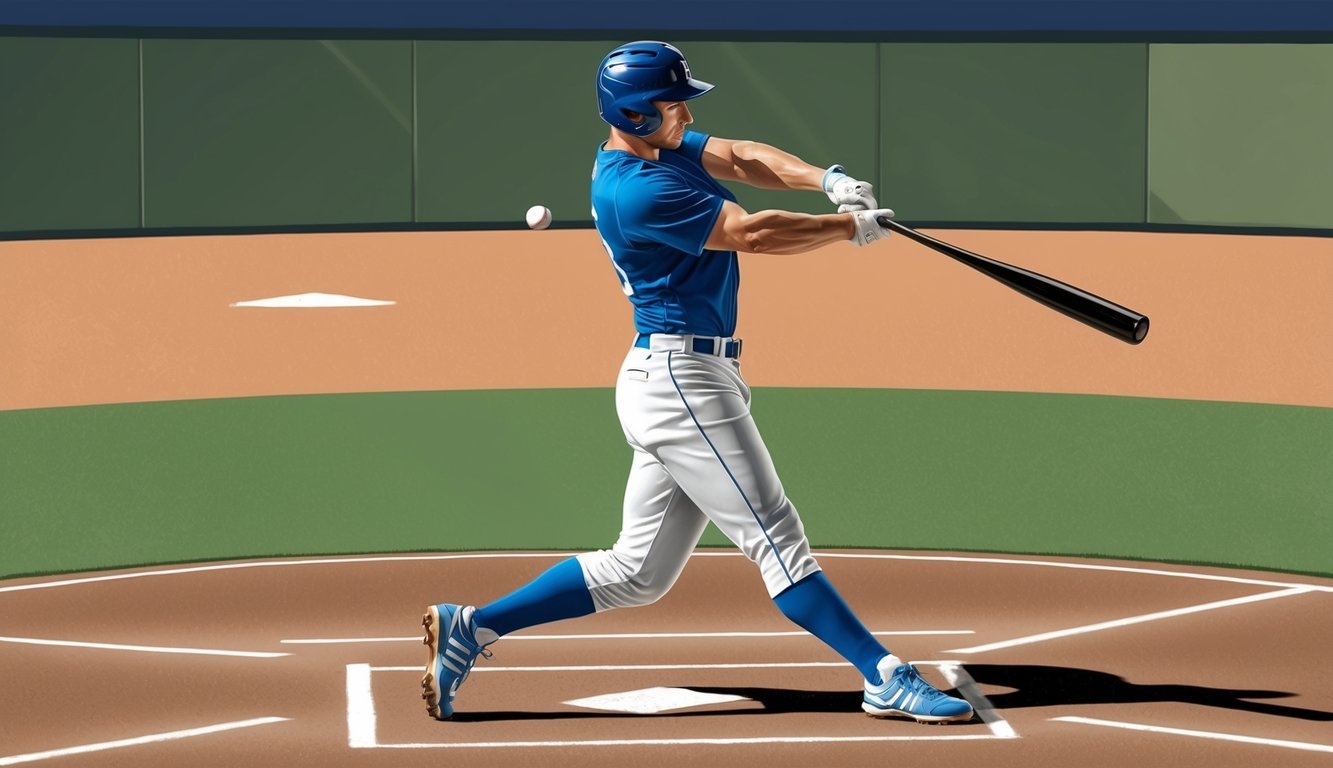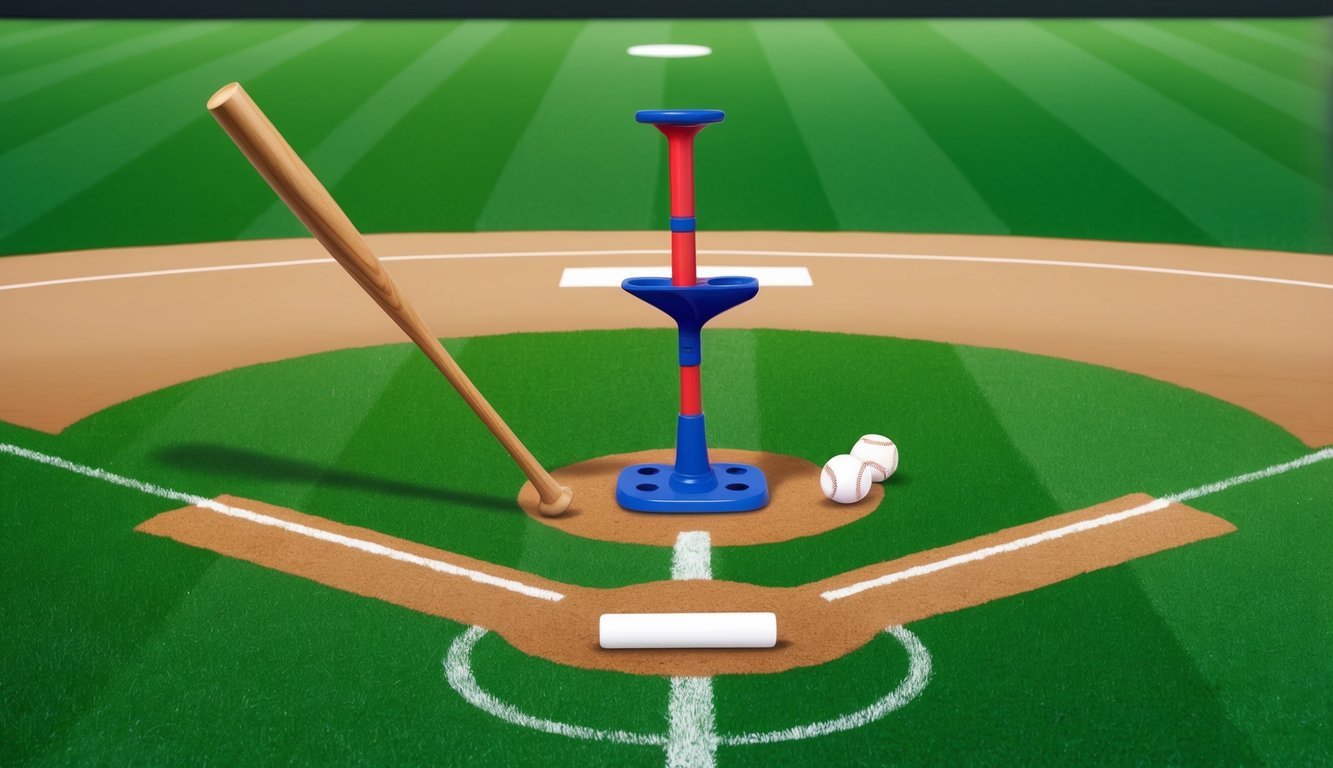Baseball hitting drills help players of all ages and skill levels improve their swing mechanics and overall performance at the plate.
From warm-up exercises to technical drills focused on timing, rhythm, and power, there are numerous ways to enhance batting skills through dedicated practice.
Effective baseball hitting drills can help players develop proper form, increase bat speed, and improve contact with the ball. Regular practice with these drills allows hitters to build muscle memory and refine their technique, leading to more consistent performance during games.
Many drills can be performed individually or with minimal equipment, making them accessible for players to work on at home or in small practice spaces.
Safety is paramount when conducting hitting drills, especially for younger players.
Proper supervision and the use of appropriate protective gear are crucial to prevent injuries while maximizing the benefits of training.
With a commitment to learning and consistent practice, players can see significant improvements in their hitting abilities over time.
Fundamentals of Hitting
Mastering the fundamentals of hitting forms the foundation for success at the plate.
A solid understanding of the strike zone and a consistent batting stance are crucial elements that every hitter must develop.
Understanding the Strike Zone
The strike zone is the area over home plate where pitches are called strikes.
It extends from the batter’s knees to the midpoint between their shoulders and belt.
Recognizing this zone is essential for making good decisions at the plate.
Hitters need to develop a keen eye for pitches within their hitting zone.
This helps them lay off bad pitches and attack good ones.
Practice drills often involve watching pitches without swinging to improve pitch recognition.
Coaches may use visual aids like a strike zone mat or markers on a fence to help players visualize the zone during practice.
This reinforces the mental image of where strikes are called.
Developing a Consistent Batting Stance
A good batting stance provides balance and sets up the body for a powerful swing.
Feet should be shoulder-width apart, with weight evenly distributed.
Knees are slightly bent, creating a stable base.
The grip on the bat is crucial.
Hands should be lined up, with knuckles aligned.
This allows for quick wrist action during the swing.
The bat is held at a comfortable angle, neither too upright nor too flat.
Head position is key.
Eyes should be level, focused on the pitcher.
This stance allows for a clear view of incoming pitches.
The front shoulder is slightly tucked, with the back elbow comfortably positioned.
Consistency in stance is vital.
It allows hitters to repeat their mechanics and timing pitch after pitch.
Regular practice in front of a mirror or with video feedback can help refine and maintain a solid stance.
Mechanics of a Powerful Swing
A powerful baseball swing combines several key elements to generate maximum force and accuracy.
Proper mechanics involve the entire body working in sync to deliver the bat to the ball with speed and precision.
In addition to body mechanics, a strong mental approach is crucial, as the batter must remain focused and confident in their swing.
Practicing key techniques such as stance positioning and grip strength can greatly enhance performance, making these batter’s box essentials for better swings.
Ultimately, mastering these components will not only improve overall hitting but also increase the enjoyment of the game itself.
The Role of Hip Rotation
Hip rotation is crucial for generating power in a baseball swing.
As the batter starts their swing, the hips initiate the movement, creating a kinetic chain that transfers energy through the body.
This rotation should be explosive, with the hips leading the upper body.
To practice hip rotation, batters can use a resistance band tied to a fence.
They should focus on rotating their hips quickly while keeping their hands back.
This drill helps develop the muscle memory needed for a powerful swing.
Another effective exercise is the medicine ball rotation throw.
Batters can stand sideways and explosively rotate their hips while throwing a medicine ball, simulating the motion of their swing.
Importance of Hand-Eye Coordination
Hand-eye coordination is essential for making solid contact with the ball.
Improved coordination allows batters to track the pitch more effectively and time their swing accurately.
One popular drill to enhance hand-eye coordination is soft toss.
A partner tosses balls from the side, and the batter focuses on hitting them squarely.
This drill can be varied by using different sized balls or changing the toss speed.
Another effective exercise is the rapid fire drill.
Batters face a pitching machine set to release balls quickly.
They must react and make contact with each pitch, improving their reaction time and coordination.
Mastering the Point of Contact
The point of contact is where the bat meets the ball, and mastering this aspect of hitting is crucial for power and consistency.
Batters should aim to make contact slightly in front of their front foot, with their arms extended.
Tee work is an excellent way to practice the point of contact.
Batters can set up a tee at various heights and locations in the strike zone, focusing on hitting the ball squarely with proper extension.
The colored ball drill can help batters improve their focus on the point of contact.
They use balls with different colored halves and try to identify the color facing them at the moment of contact.
This drill enhances concentration and teaches batters to keep their eyes on the ball through contact.
Effective Drills for Skill Enhancement

Baseball hitting drills help players refine their technique, build muscle memory, and boost confidence at the plate.
These exercises focus on key aspects like precision, timing, and power.
Tee Drills for Precision
Tee drills are excellent for honing swing mechanics and improving bat control.
Players can practice hitting different pitch locations by adjusting the tee height and position.
The High Tee Drill is particularly useful for mastering high fastballs.
Set the tee at chest height and focus on maintaining a level swing path.
This helps prevent pop-ups and teaches batters to drive the ball with authority.
Another effective variation is the Walking Happy Gilmore drill.
Start a few feet behind the tee, take a couple of steps forward, and swing.
This drill enhances weight transfer and timing.
Aim for 20-30 repetitions per session to build consistency.
Soft Toss Drills for Timing
Soft toss drills bridge the gap between stationary tee work and live pitching.
A partner tosses balls from the side, allowing hitters to practice timing and pitch recognition.
The Angled Toss drill simulates different pitch angles.
The tosser kneels about 45 degrees in front of the batter, varying the release point.
This helps batters adjust to different pitch types and locations.
For added challenge, try rapid-fire soft toss.
The partner quickly tosses 5-10 balls in succession, forcing the batter to reset quickly between swings.
This drill sharpens focus and reaction time.
Bucket Drill and Chair Drill
The Bucket Drill improves balance and lower body stability.
Place a 5-gallon bucket upside down in the batter’s box.
Stand on it with your back foot and practice your swing.
This forces proper weight distribution and prevents lunging.
The Chair Drill targets rotation and hip drive.
Sit sideways on a chair with your chest facing the pitcher.
Swing the bat, focusing on explosive hip rotation.
The chair provides resistance, helping to build core strength and rotational power.
Both drills can be performed with or without hitting a ball.
Start with 10-15 swings and gradually increase as you build strength and comfort.
Remember to maintain proper form throughout each repetition.
Advanced Techniques for Seasoned Players

Experienced baseball players can refine their hitting skills with specialized drills.
These techniques focus on adapting to various pitch types and building strength for improved performance at the plate.
Adjusting to Different Types of Pitches
Seasoned players benefit from drills that simulate diverse pitching styles.
The low tee drill helps hitters practice their swing on low pitches, improving their ability to handle breaking balls.
Players can set up a tee at knee height and focus on maintaining a level swing path.
For fastballs, hitters can work on quickening their hands with rapid-fire soft toss drills.
A partner throws balls quickly from a short distance, forcing the batter to react swiftly.
This drill enhances hand-eye coordination and bat speed.
To prepare for off-speed pitches, players can use a pitching machine set to varying speeds.
They should focus on staying back, recognizing pitch type, and adjusting their timing accordingly.
Building Strength with a Heavier Bat
Using a heavier bat in practice can boost a player’s strength and bat speed during games.
Start with a bat that’s 2-3 ounces heavier than the game bat.
Take regular swings, focusing on maintaining proper form and rhythm.
Incorporate the heavy bat into tee work and soft toss drills.
This helps players develop muscle memory for a powerful, controlled swing.
As strength improves, gradually increase the weight difference.
Players should alternate between heavy and regular bats during practice sessions.
This contrast helps highlight the feel of a faster swing with the game bat.
Remember to limit heavy bat use to avoid developing bad habits or risking injury.
Preparation and Practice Routines

Proper preparation and structured practice routines are essential for baseball players to improve their hitting skills and perform at their best.
These routines help prevent injuries and maximize the effectiveness of training sessions.
Warm-Up Exercises to Prevent Injury
Warming up before hitting practice is crucial for injury prevention and optimal performance.
Start with light jogging or jumping jacks to increase heart rate and blood flow.
Next, perform arm circles and shoulder rotations to loosen up the upper body.
Incorporate dynamic stretches like leg swings and torso twists to improve flexibility.
Focus on hip mobility exercises, as the hips play a key role in generating power during swings.
Finish with some light swings using a weighted bat or two bats together.
This helps activate the muscles used in hitting without overexertion.
Creating Effective Practice Sessions
Structure batting practice sessions to maximize productivity and skill development.
Begin with tee work, focusing on proper form and contact.
Make sure to set up the tee at different heights and locations to practice hitting various pitch types.
Next, move on to soft toss drills.
Have a partner or coach toss balls from the side.
This helps develop timing and pitch recognition.
Gradually increase the speed and variety of tosses.
After that, incorporate live batting practice with a pitcher or pitching machine.
Mix up pitch types and locations to simulate game situations.
You can also use colored balls or number them to improve visual tracking.
Finally, end sessions with situational hitting drills.
For example, you can practice hitting to specific fields or executing hit-and-run plays.
This helps players apply their skills to game scenarios.
